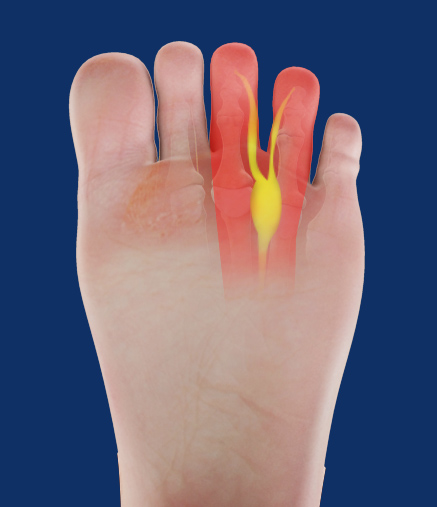
Morton’s Neuroma is a common condition that can cause foot pain and discomfort, and if left untreated, can lead to more serious issues. If you’re experiencing foot pain or discomfort, it’s important to seek the advice of a Podiatrist. At Borders Podiatry and Performance Clinic, we specialise in the diagnosis and treatment of foot conditions, such as Morton’s Neuroma, and we’re here to help you find relief.
What is Morton’s Neuroma?
Morton’s Neuroma is a condition that affects the nerves in the foot, causing pain and discomfort. It is characterised by a thickening of the tissue that surrounds the nerve between the third and fourth toes in the ball of the foot. This thickened tissue compresses the nerve, causing pain, numbness, and tingling in the toes. The exact cause of Morton’s Neuroma is unclear, but it is thought to be caused by repeated stress on the foot, such as from high-impact sports, or by wearing tight, ill-fitting shoes.
Who is at risk of Morton’s Neuroma?
Morton’s Neuroma is more common in women than in men and typically affects people in their 40s and 50s. Women who wear high heels or other tight shoes are at a higher risk of developing the condition. Other factors that may contribute to the development of Morton’s Neuroma include foot deformities, high-impact sports, and certain occupations that require standing for long periods of time.
Symptoms of Morton’s Neuroma
The most common symptom of Morton’s Neuroma is pain in the ball of the foot, which can extend to the toes. The pain is often described as sharp or burning and may be relieved by removing shoes or massaging the foot. Other symptoms of Morton’s Neuroma may include numbness or tingling in the toes, a feeling of a pebble or a lump in the shoe, and swelling between the toes.
Treatment Options for Morton’s Neuroma
At Borders Podiatry and Performance Clinic, we offer a range of treatment options for Morton’s Neuroma, depending on the severity of the condition. In mild cases, conservative treatments may be recommended, such as orthoses or shoe inserts to provide better foot support and reduce pressure on the nerve. Our expert Podiatrists can help you determine which type of orthotic is best suited to your individual needs.
For moderate to severe cases, we may recommend more advanced treatment modalities such as MLS Class 4 laser therapy and Shockwave Therapy. These newer treatments have been shown to be highly effective in reducing inflammation and pain, and promoting healing.
In some cases, surgery may be recommended. The surgical procedure involves removing the thickened tissue that is compressing the nerve. Surgery is typically only recommended when conservative treatments have failed.
Conclusion
Morton’s Neuroma can be a painful and uncomfortable condition, but with the right treatment, it can be managed effectively. If you’re experiencing foot pain or discomfort, come and see us at Borders Podiatry and Performance Clinic. Our expert podiatrists can help you determine the best course of treatment for your individual case. Additionally, taking care of your feet by wearing comfortable, supportive shoes and practicing good foot hygiene can help prevent the development of Morton’s Neuroma. Don’t suffer in silence, book an appointment today! Click here to Book
